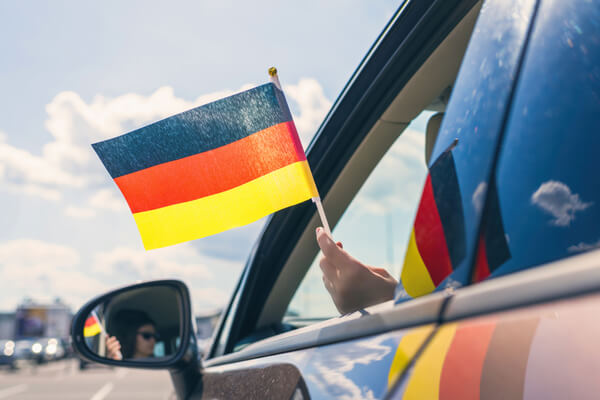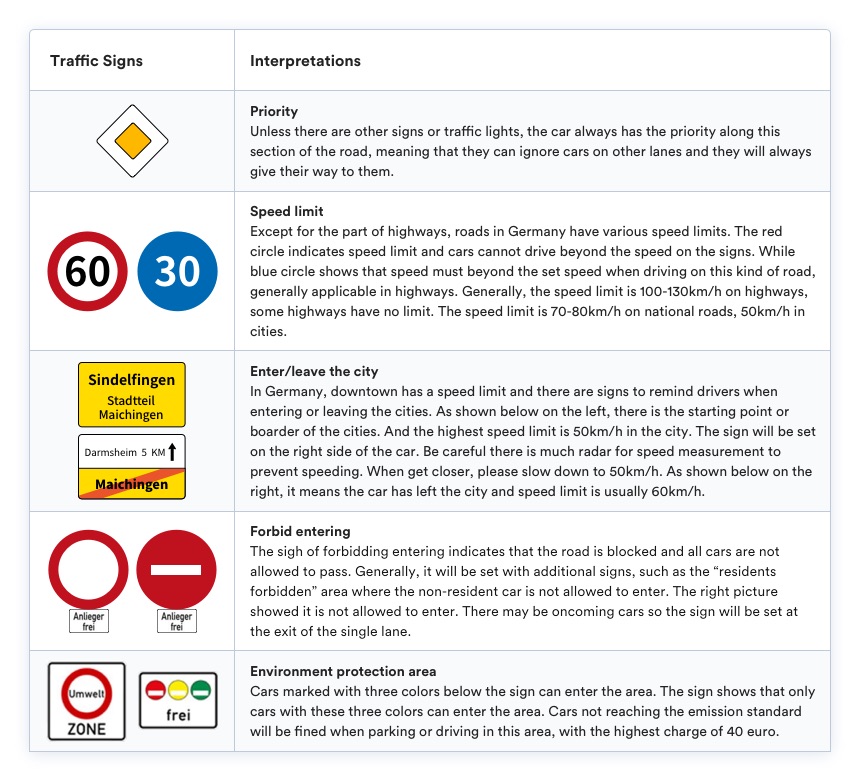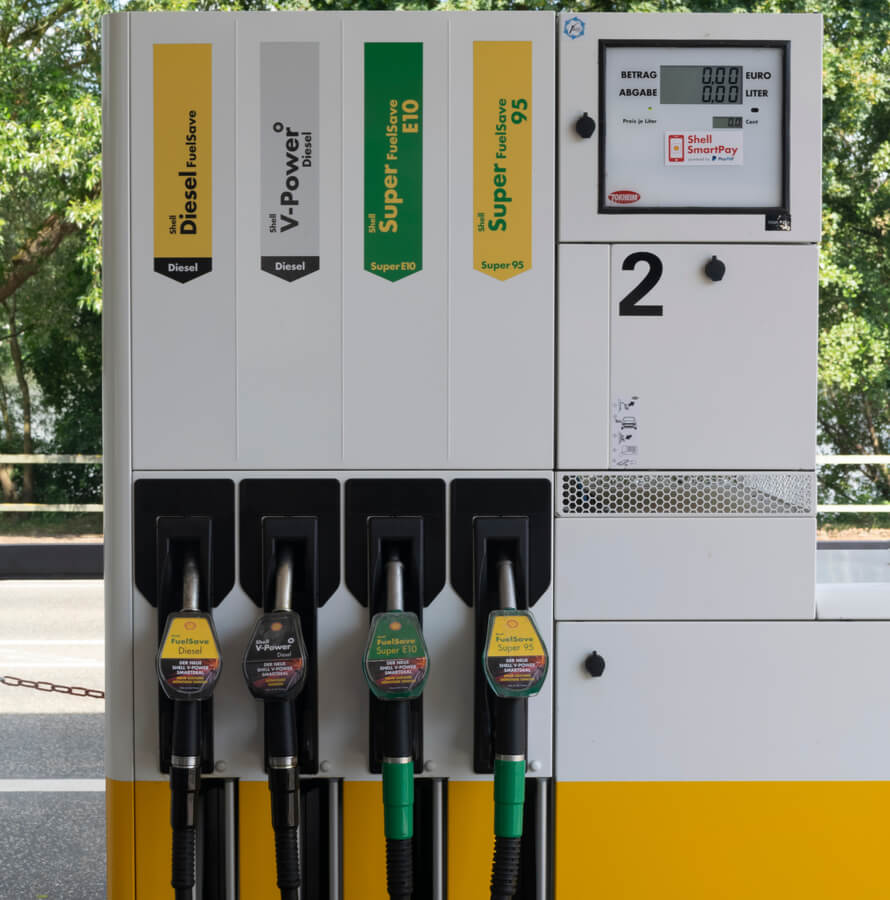Although public transport is well-developed in Germany, there are many towns and small cities where need to transfer to big cities like Frankfurt. You need to follow the timetable to plan your schedule if you want to take public transport, which is not so flexible as a self-drive tour. Taking a self-driving tour is the most efficient way to travel in Germany.
1. Driving Rules and Tips
- Speed Limit
i. Urban arterial roads – 60 or 70km/h
ii. Rural roads – 100 km/h: except for motorways or other designated fast roads
- Traffic and Road Signs
For more information about German road signs, here is an infographic from QEEQ.COM.
2. Road Condition and Toll Roads
- Road Condition
Most of the highways in Germany are two-way four-lane with good quality and the road condition. Speed is not limited on most of the highways, and there are a few speed-limit sections, ranging from 80 km/h to 130 km/h, some also with the weather and time-related conditions; these places may have a variety of fixed or flow camouflage speed gauges. Pay attention to observe speed limit regulations.
There are no street lamps on the road out of the urban area, including highways. If you are not familiar with the road condition, please don’t drive too fast and judge the upcoming road condition. National highway and the provincial road is usually narrow and curved, and the vision in the mountain area is also limited, so it is difficult to drive. If you are not sure the road condition, do not follow the high-speed driving blindly, keep your pattern, pay attention to safe driving.
- Toll Roads
Germany is the only country that restricts speed on the highways. Therefore drivers can enjoy lightning speed ensuring safety. But speed is not limited on the whole highway. Generally speed limit is 80km/h near the city, dangerous or constructing the area, 110-130km/h in some highways.
If you are on a three-lane highway, the far right lane is usually for container trucks, the middle lane is mainly for cars and buses, and the leftmost lane is for overtaking. Go back to the right lane as soon as possible after overtaking.
It is illegal when driving on the highway the petrol is used up. Therefore be careful about the gauge. It is better to prepare the anther tank in the car.
Are there any toll highways in Germany?
Cars are free of charge on the highway. But if you travel across neighboring countries, remember to check how toll road charges. Be careful when driving at the border between Germany and Austria. If there is a toll on the Austrian highway, you must buy a pass at a roadside shop or gas station and show it on the front glass. Since there is no obvious border mark and there is no toll station, special attention should be paid to it. If you don’t buy a high-speed fee in Austria, you’ll be fined if you’re caught by the police.
3. Gas
The petrol price is quite high because part of the tax on the petrol price is contributed to road construction. The price is 1.5 – 1.7 euro per liter, diesel is 1.4 euro per liter.
Petrol in Germany is mainly divided into two types: Super Plus (NO.98) and Super (No.95). Some gas stations will provide Super-E10 (a kind of No.95 environmental-friendly petrol).
When refueling in Germany, you can follow the instructions on the car or the fuel tank cap and fill the tank with the designated fuel. If you are not sure which fuel to choose, consult the branch staff when picking up the car.
Expert tips:
1. Austrian petrol prices are about 20% cheaper than Germany’s. And if you pass Austria, you can empty the tank and fill it up when coming back.
2. Be careful not to fill the tank with the wrong fuel. If you refuel with the wrong fuel, please contact the branch as soon as possible to clean up the fuel tank and the fuel system and conduct an overall inspection of the engine. Don’t start the car in haste to avoid car damage.
How to pay?
Gas stations are divided into self-service gas stations and half self-service gas stations.
- Self service gas station
Step1: Insert the credit card
Step2: Enter the information as required
Step3: Start to refuel
Step4: Print the receipt
Step5: Take out the card
- Half self-service gas stations
Step1: Remember the nozzle number
Step2: Pay at the counter by card or in cash
Step3: Choose the petrol type at the pump
Step4: Pick up the fuel pump nozzle and start filling up
Step5: Get the receipt at the counter
Some gas stations only allow customers who bought the refuel cards (like membership card) to refuel. On this occasion, you have to go to another one.
Expert tips:
1. Gas stations along the road and in the resorts are relatively rare and expensive to refuel. It is recommended to leave with full tank.
2. It is recommended to prepare cash when refueling. Cash is more favorable than credit card in some gas stations.
4. Parking
- Public parking
There are free public parking lots around the shopping center and supermarkets. Generally, in the scenic spots and prosperous areas, paid parking lots are available. There is a limited parking area in popular resorts. Sometimes it is hard to find the place, such as resorts in Berlin. It is suggested to find the parking space in advance.
The entrance and exit of the charging parking lot are generally machine-controlled, surrounded by road signs, with numbers indicating free parking spaces. Note that the ‘Frei’ means the number of parking left, not free. If the parking space is full, there may be a red ‘(a) Besetzt’ mark.
- Parking at the roadside
When parking at the roadside, there is ‘Mit Parkschein’ sign and parking for 10mins, half an hour, an hour. An automatic selling machine will be set at a regular distance nearby. As the sign below, parking is allowed in this area and there is a machine for parking tickets.
- Limited free parking at the roadside
Parking at the roadside within 1-2 hours is for free. As the sign is shown, the arrow points. Parking is for free within weekday 8 am-6 pm, the weekend at 8 am-2 pm. Generally, it requires the counting sign. Parking beyond the time limit will be considered illegal parking and may be affixed with a ticket.
How to pay?
Parking in Germany is generally self-service payment.
- Self-payment at the roadside
Step1: Put in coins /insert the card
Step2: Select the time
Step3: Confirm ok
Step4: Print the receipt
Step5: Place the receipt on the windshield
- Pay at the parking lot
Step1: Get the timing card at the entrance
Step2: Pay at the Kassenautomat
Step3: Insert the card into the machine and leave
Expert tips: Please remember to put the parking tickets at the windshield for inspection. If you lost it , regardless of parking time, you will be charged at the highest price.
5. Tickets
The rental company may pay the fine for you if there is unknown fine when coming back. But usually it is more expensive than the fee for breaking rules, which is included administration fee from the rental company.
If there is no illegal record, the deposit will be unfrozen and returned to the credit card of the main driver.
How to pay?
There are two ways to pay the fine: pay through ATM or at the counter. Make sure to pay the fine on time or an extra fee is needed.
If you cannot pay right away, inform the car rental company when dropping off the car. And they can charge on your credit card but an extra fee will be charged.
Expert tips: It would be better to check whether there is a toll road and toll bridge while traveling. And some possible illegal behaviors. If there is a fine, pay as soon as possible or a higher extra fee will be charged.
Visit QEEQ.COM now.
QEEQ.COM guarantees the most competitive car rental deals for your travel and the secret is our Price Drop Protector program! We can automatically track your rental rates and RE-BOOK you if prices drop! See how our customers love this feature here.





